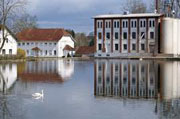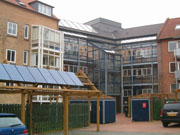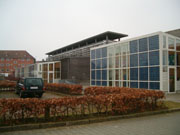Kolding Municipality - Municipal energy planning
Kolding municipality has from an early stage initiated local energy planning and has now established a local climate and energy strategy. The municipality's initiatives include:
- Approval of energy plan
- Formation of energy commission
- Systematic energy management of municipal properties
- Requirement of low energy class 1 in new construction projects
The municipality was appointed energy city by the Danish Ministry of Climate and Energy in 2008. The 5 other energy cities are Herning, Copenhagen, Skive, Albertslund and Aarhus.
The municipality participates in the Green Cities cooperation and has signed a curve breaker agreement on a 2% annual electricity reduction in the period 2008-10 with The Danish Energy Saving Trust. They have signed an agreement (June 2008) of becoming a climate municipality with the Danish Society for Nature Conservation on a 2% reduction of CO2 each year until the year 2021.
Page content
From Agenda 21 to climate strategy
Kolding Municipality integrated sustainability in the local agenda at an early stage. In 1994, the municipality signed the Aalborg Charter (charter of European cities for sustainability), where the municipality commits to become a driver for a local sustainable development. This commitment was later confirmed in 2004 by signing the Aalborg Commitment, where the municipality accepts to set out concrete objectives for their Agenda 21 work and report progress towards these objectives.
In addition to this Kolding has been part of Green Cities (formerly Dogma 2000) and part of the international cooperation between municipalities working with sustainability - ICLEI (International Council for Local Environmental Initiatives).
The Green Cities cooperation is based on a set of dogmas, which requires the municipality to:
- Measure and report (green accounting) the impact on nature from the municipality, residential areas and businesses
- Set objectives for consumption of resources and environmental impacts in local Agenda 21 plans
- Root the work locally in residential areas, industry and the municipality itself.
In relation to climate, municipalities have committed to reducing emissions of CO2 by 25% in 2015 (compared to emissions in 2006).
Kolding municipality has gone further and has with the energy plan “Energy Kolding” set the ambitious goal of reducing CO2 emissions by 75% per capita in 2021 (compared to 1990 = 100, Kyoto Protocol reference year). Within the same time frame (2021) renewable energy must constitute 30%. It is also an objective that Kolding municipality must be a leader in energy conservation and energy efficiency.
The plan is developed in collaboration with “Business Kolding” and has as a key element the creation of a development facility for renewable energy (Energy Park Kolding)
“Energy Kolding” is under review. New revised plan should be adopted in autumn 2009. .
In 2009 the municipality has established an independent and strengthened environmental department (climate and sustainability) under the technical department, which manages issues relating to climate and environment. It acts as the municipality's climate secretariat and coordinates efforts on climate change.
Energy management
Kolding Municipality has since 1986 registered energy and water consumption in municipal buildings as an effort of stopping local overconsumption. The Aalborg Charter instructs the municipality to reduce consumption of water and energy and the municipality went from registration to an actual management of municipal energy consumption. At the same time energy efficiency was connected to maintenance and new constructions. In 1995, the municipality employed an energy coordinator to implement these plans. The municipality has in the implementation made efforts of building its own capacity to implement energy improvements and management (rather than outsourcing).
In the programme “Energy management in Kolding Municipality” (1996), the target was a 20% reduction of water and a 15% reduction of energy consumption in 2005 (compared to 1988). In relation to implementation the programme introduced a number of tools, including:
- Preparation of annual progress reports and plans of action
- Systematic registration of consumption and analysis of selected buildings as a basis for a prioritized effort
- Organizational: energy steering group (with the participation of all administrations) and designation of individuals responsible for energy in all the municipal buildings (155 persons)
The efforts are addressed at construction of buildings, technical installations, operation and / or behavior and attitudes. The person responsible for energy reports on consumption assists on implementation of energy plans and communicates energy information to employees and users.
The requirements for these projects were that investments in electricity should have a payback time of 5 years and investments in heat savings 8 years. Longer payback times are now accepted, for example with investment in heat recovery ventilation systems. In relation to improvements of building envelope (not part of energy management) payback times of 15 years are accepted (projects relating to more than 25% of the building envelope the property shall meet the requirements of Building Regulations).
The systematic mapping of the building stock was used to prioritize and implement coordinated efforts, such as simultaneous replacement of electrical fixtures in the group of buildings where it had the largest savings potential
The result has been an actual reduction in the energy consumption. Among other things, there has been a decline in municipal energy consumption of approximately 16% in the period 1988 - 2006. Investments of 20 million DKK in the period has given annual savings of 6 million DKK.
Recent initiatives include a web-based registration of consumption, which offers opportunities for faster response, both centrally and locally, and efforts of integrating energy conservation into all maintenance projects. One problem with the efforts has been the tradition of local management of smaller maintenance projects; the problem is often the lack of local knowledge in order to ensure that reconstructions are used systematically to improve the energy efficiency of buildings. Another problem is that energy efforts (focusing on energy conservation and efficiency) and building maintenance, including improvement of the building envelope and heating systems, are located in two different departments / budgets of the municipality.
The municipality has agreed on a stage 2 for energy conservation (12.5 million DKK) for the period 2008 -2015. The goal here is that consumption of Kolding municipality-owned and leased buildings will be reduced by 11,5% for heat, 11% for electricity and 20% for water (compared to 2006). Overall, the objective is a 60% reduction in CO2 emissions from energy consumed in municipal-owned and leased buildings in 2020 (compared to 1990). These efforts are now included as part of an overall climate plan: Energy Plan Kolding. -udledningen fra energiforbruget i kommunens ejede og lejede bygninger i 2020 i forhold til 1990.
Energy plan: Energy Kolding
Kolding municipality prepared in 2007 the energy plan “Energy Kolding”. In this plan the municipality set out an objective of reductions of CO2 emissions by 75% per capita in 2021 (1990 = 100) and a renewable energy share of 30%. The plan operates with 5 areas of efforts:
- Citizens
- The municipality
- Transportation
- Construction
- Businesses
As part of the plan Kolding identified the municipality's CO2 emissions. Emissions are 10 tons of CO2 (equivalent to the national average). The distributions of emissions are:
- Individual heating 14%
- District heating 6%
- Agriculture 12%
- Electricity consumption (private and business) 38%
- Transportation 29%
The plan is under revision (new plan should be adopted in autumn 2009)
The municipality works to act as a role model on energy consumption. In relation to the accounts the municipal consumption constitutes only a few percent. At the same time the municipality is working on integrating local actors into the strategy. The municipality participates for example in collaboration on education of ambassadors on environment and energy in the housing associations departments (such as integration of energy renovations and behavior).
Green buildings: Environmental guide for construction
In 1999 the municipality prepared a guideline for ecological planning and construction applying to municipal buildings and the subsidized construction, but it was also handed out to private construction projects in the municipality. The guide is at present (March 2009) under review.
Requirements of low energy class 1
The municipality has decided that requirements in new local plans (and municipal buildings) must comply with the low energy class 1. The municipality chose to take the full step instead of using resources to manage an intermediate stage with requirements of low energy class 2 in local planning and reviews of building licenses. At the same time it was the perception that it was more forward looking in relation to development of the local construction industry.
The requirement of low energy class 1 is not part of existing local plans. Other municipalities examine opportunities to extend the requirements (see Middelfart), but the need for investments in district heating and the problem of introducing new requirements for landowners have refrained Kolding municipality from taking this step.
Construction in low energy class 1 or passive houses cause higher prices. A number of Danish projects have experienced difficulty in selling land and houses with stricter requirements (e.g. Comfort houses). The municipality has estimated that the long-term benefits outweigh any problems in attracting projects on the current market.
Buildings in the Municipality of Kolding
Municipal
The Glass pyramid from 1994 (Fredensgade-Hollændervej) is part of an urban ecology project where rainwater is utilized for flushing toilets and clothes washing and where, locally in the glass pyramid, an innovative water treatment plant has been established which purifies sewage effluents from the block according to biological principles. All sewage effluents and rainwater will be biologically treated in tanks inside the glass pyramid, after which it is channeled through a biological treatment plant (root zone) and further down into the groundwater. The settlement is connected to the municipal sewage plant but the connection is not intended to be used and the residents do not pay discharge fees. The plant is part of an urban ecological courtyard. The project was supported by the Urban and Housing Ministry.
The “Kvarterhus” is an activity house constructed as a demonstration project in 2002 according to resource-conserving, environmentally friendly and sustainable principles. The house was established as part of an overall neighbourhood regeneration project (Neighborhood Plan Southwest Quarter, 1998) The house utilize the sun to heat rooms, and production of hot water and electricity, and it is equipped with a computer controlled management system which minimize energy spillage
A new care centre is constructed as a passive house (15kWh/m2) (2009).
Private developers
The passive house construction “Golfen”: Denmark's first multi-storey buildings built according to passive house standards (2009). The 1st stage consists of 8 apartments with a heat consumption of 12 kWh/m2 per year. The shell and air-tightness was carried out by a German contractor. The Danish producer Protec has supplied windows. The additional cost is estimated at 5%. A total of 40 apartments are projected. They will be connected to the municipally owned district heating plant Trefors. The municipality has supported the project by collecting only one connection fee.
Kolding Company Park. NCC Property has built an office building in Kolding within their Green Building concept (low energy class 1). The concept aims at always being 25% below current energy requirements for buildings.
“Solgården”
Solgården is a residential building in Kolding,
which has an extensive photovoltaic plant, both on
the roof and on balconies. Solgården’s photovoltaic
plant was established in connection with a thorough
renovation of the property in 1998. The plant is
Denmark's largest facility integrated into a
residential building.
Funkis Park. Is a 25.000 m2 office building, where the developer in the future will build according to low energy class 1, although the local plan for the area was made prior to the introduction of the stricter requirements.
Sunshine House. The development company Nordicom planned the construction of 12 relatively cheap passive houses in Kolding (Dalbygaard) in collaboration with the Danish Technological Institute and the Knowledge centre for Industrial Building (VIB). 4 consortiums have been prequalified to bid on the project.




